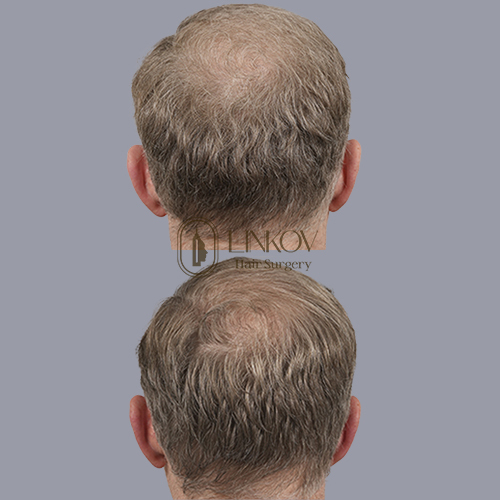Male Pattern Hair Loss Treatment NYC
Male pattern baldness is one of the most common forms of hair loss in men. Female pattern hair loss also is a common genetic trait in women. Neither is a lost cause, however, if you’re not happy with the changes in your hairline. Male pattern hair loss is best treated when you first notice hair loss in the front of your scalp. Men under 50 have the greatest chance of successful treatment, but anyone may be eligible for some level of hair restoration at Linkov Hair Surgery in New York City. Call today to find out if you qualify for treatment of your male pattern baldness.

What Is Male Pattern Hair Loss?
Male pattern baldness is a genetic characteristic that causes a gradual receding hairline and a thinning of the crown, usually in a pattern shaped like the letter M at the top of your head. This trait, passed from mother to son, affects 30 to 50 percent of men by the age of 50. This genetic condition is also known as androgenetic alopecia.
This common genetic trait is traced to an excess of male hormones that cause your hair follicles to shrink and produce smaller, thinner hair that’s more likely to fall out. Although there’s no absolute cure for male pattern hair loss, modern medicine and cosmetology practices have created many creative and effective treatment options to combat early hair loss.
For the best male pattern hair loss treatment in Manhattan, rely on a top hair restoration doctor in the field of hair restoration at Linkov Hair Surgery. You’ll find a wealth of treatment options here, as well as a firm diagnosis.

What Causes Male Pattern Baldness?
The thinning of hair follicles is due to an overproduction of male hormones, like testosterone and dihydrotestosterone (DHT). As a genetic trait, male pattern baldness is a characteristic passed down from family member to family member.
Hair follicles are small pockets underneath the skin that produce a hair once every three years. This growth cycle continues unless it’s interrupted. In male pattern baldness:
- The growth cycle is shortened.
- Less hair is produced from each follicle.
- Hair follicles shrink.
- Follicles produce smaller, thinner strands of hair.
- Hairs eventually fall out and don’t reproduce.

What Are Early Symptoms of Male Pattern Baldness?
Because this condition is most commonly genetic, you can ascertain, through your male family members, if you’re likely to inherit male pattern hair loss. Specifically, the males on your mother’s side of the family are most likely to pass on this gene. Sometimes, the condition skips generations, meaning you may not develop the condition. Additionally, some family members may have had treatments for hair loss that you never learned about.
To monitor your own hair loss, note any gradual or rapid thinning of hair or the appearance of bald spots over time. Generally, male pattern baldness first shows signs as a receding hairline. Consult a top NYC doctor if you notice a progression of symptoms that may indicate you’re developing androgenetic alopecia, such as:
Gradual thinning on your crown Thinning starts at the top of your scalp or the tip of your crown. Then it slowly thins out toward your ears, creating an M-shape if looking at your scalp from above.
Patchy, balding spots If you notice one or multiple areas of patchy growth and baldness, this may be a symptom of male pattern hair loss.
Sudden hair loss A physical or emotional shock can sometimes trigger hormones to act differently within your body.
Full body hair loss Although this condition is most often a side effect of a treatment like radiation or chemotherapy, it can also occur due to androgenetic alopecia.
What Are the Stages of Advanced Pattern Baldness?
The progression of male pattern baldness depends on you, but in most cases, it begins gradually, showing signs in your late teens or early 20s. Identifying these symptoms early allows your New York City doctor to treat your male patter hair loss more effectively, with a greater chance of success.
Treatment options are plentiful, especially if you’re experiencing hair loss early. Baldness gives the illusion of age; hair restoration helps you maintain a youthful appearance. The stages of pattern baldness may not happen particularly in this order, but do include:
- Minimal thinning Slight hair thinning may start to occur on the skin in between your ears and your temples. This may be noticeable only to you at first.
- Gradual receding Your hairline starts to move backward on your scalp, creating an M or a U shape on your head.
- Areas of complete hair loss Balding occurs at the top of your head, leaving a bald crown and thin, shrunken hair follicles surrounding it.
- Baldness Most of your hair falls out or shortens into very thin patches. Most, if not all, of the hair on your crown falls out, leaving a thin, remaining circle of hair on your scalp around the crown and above the ears.

What Are the Available Treatments for Male Pattern Hair Loss?
Dealing with male pattern hair loss may feel discouraging at times. Luckily the celebrity-trusted surgeons at Linkov Hair Surgery are experienced with many different types and forms of hair loss treatment for men. While treatment isn’t medically necessary, as it creates no danger to your health, you may choose some type of medication, synthetic hair or transplant to cover your balding area.
Medicines and hair transplant technology have come a long way, thanks to new scientific and technological breakthroughs. Creating a head of hair that looks and feels 100 percent natural and healthy is a main goal of the physicians at Linkov Hair Surgery. If you’re suffering from male pattern baldness, you may be an ideal candidate for one of a variety of treatments, including:
Medications Medications such as minoxidil and finasteride have proven to help men regrow healthier, thicker hair. They’re convenient as either topical or oral medications and are a much less invasive option than surgery.
Exosome therapy Exosome therapy is similar to stem cell therapy in that your scalp is infused with new messenger exosomes that promote hair growth and follicular restoration.
Corticosteroid injections Injections of corticosteroids combat the side effects of autoimmune conditions by controlling the number of male hormones produced and the messages sent to shrink hair follicles.
FUE/FUT transplants Follicular unit extraction and follicular unit transplantation have developed into some of the most effective surgical solutions for hair loss. With a high success rate and minimal-to-no scarring, these undetectable hair transplant treatments have become extremely popular.
Synthetic replacements Hair replacement systems, such as wigs and hair pieces, may work for those who want the least invasive non-medical solution. Hair replacements today look and feel natural and realistic.
Contact Linkov Hair Surgery today to schedule an initial consultation and find out what treatment may work best to treat your male patter hair loss.
Linkov Hair Surgery
150 E 56th St, #1A
New York, NY 10022
(212) 970-9404

